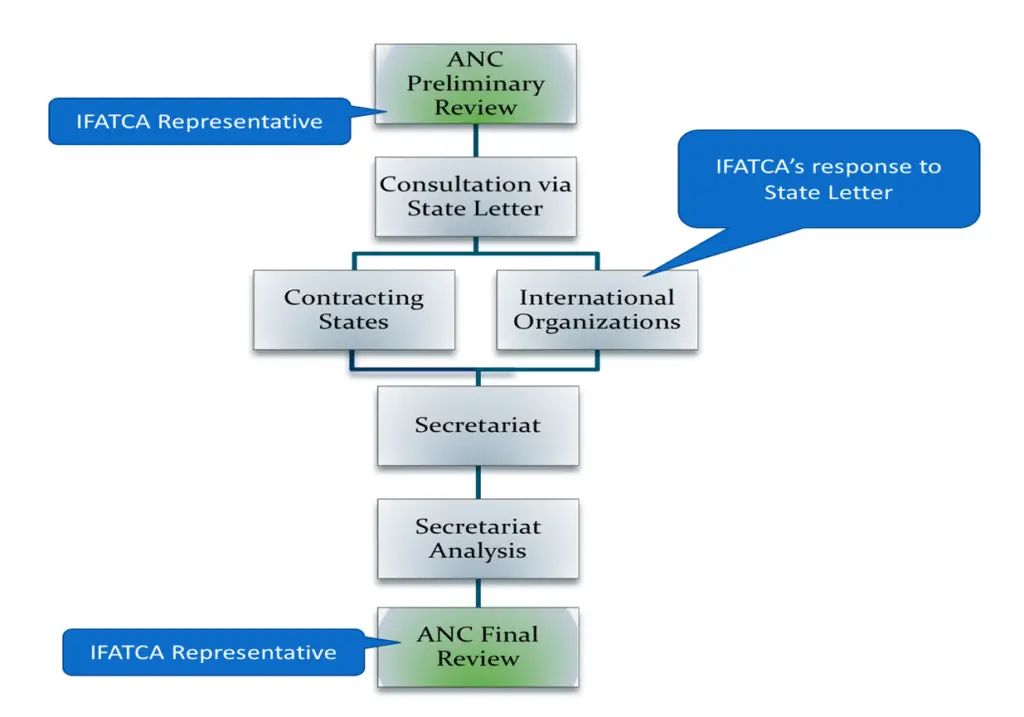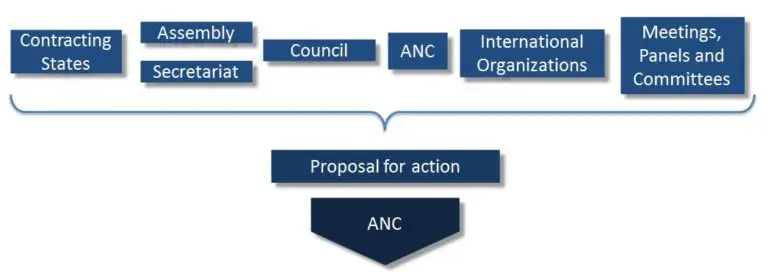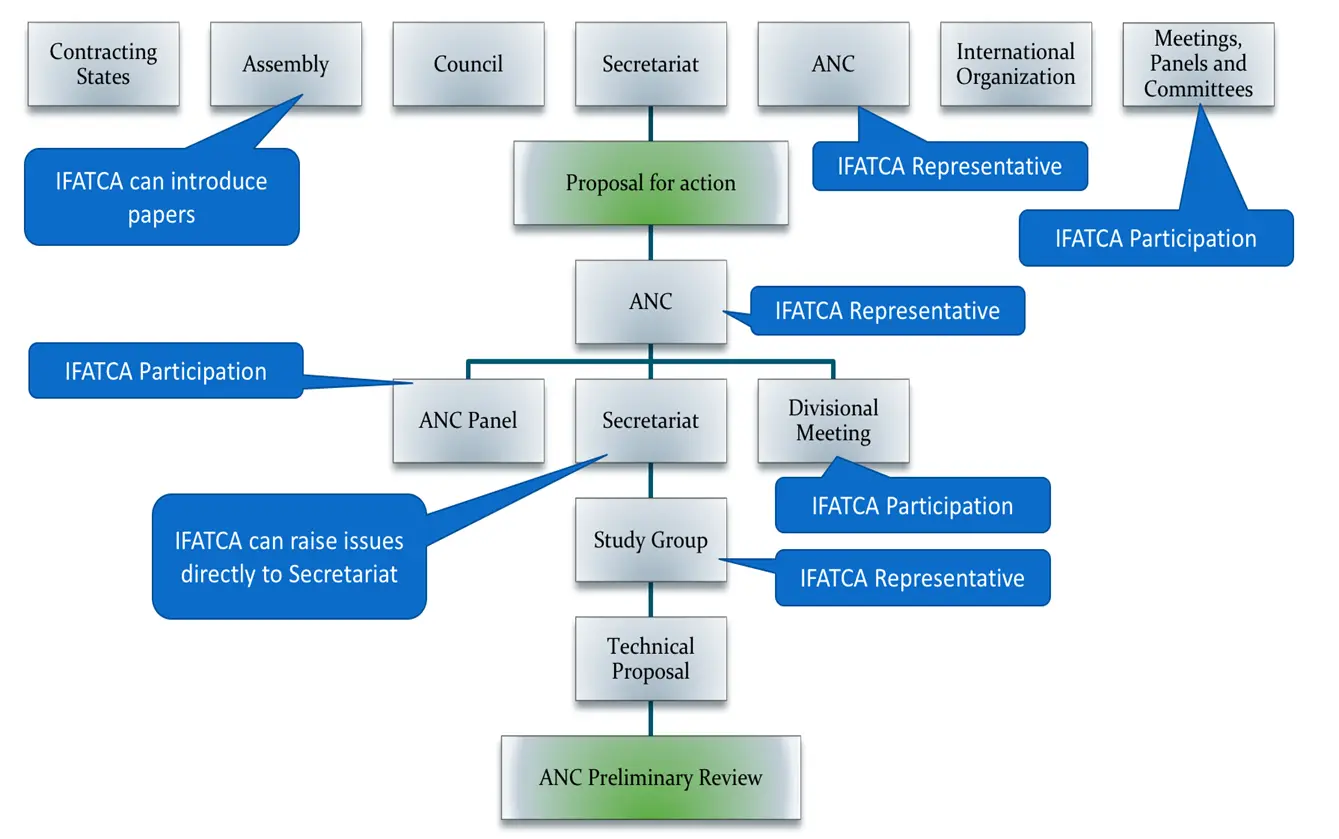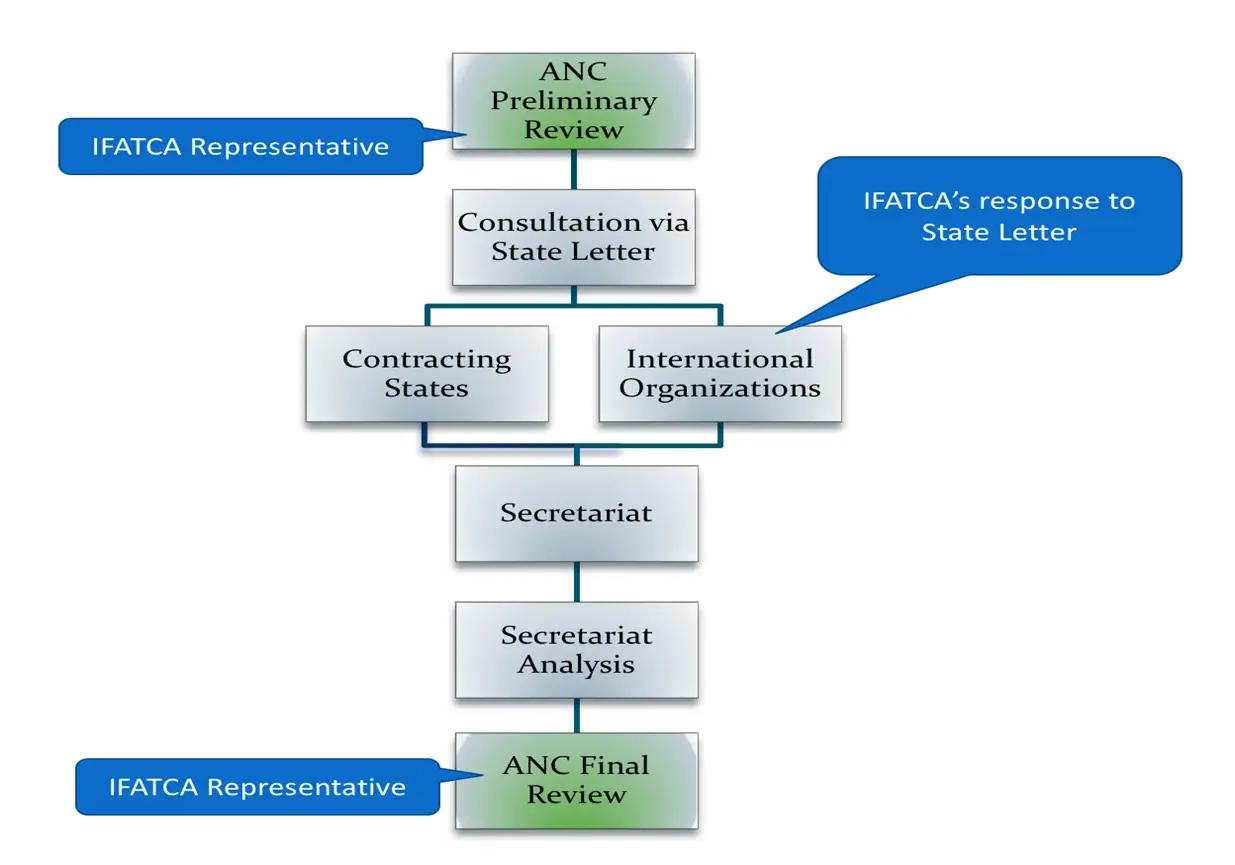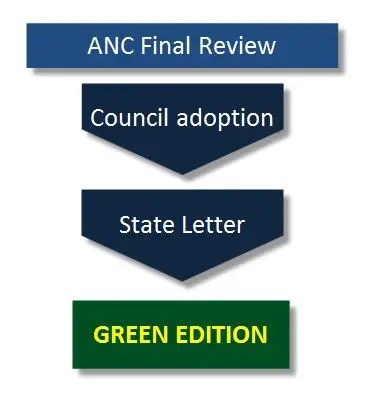Making SARPs : how does it work?
Standards and Recommended Practices (also known as SARPs) and Procedures for Air Navigation (also known as PANS) are the basic elements that complement the ICAO Chicago Convention. SARPs can be found in the 19 Annexes to the Chicago Convention and they are supplemented by six Procedures for Air Navigation:
- PANS-ABC: Abbreviations and Codes
- PANS-AERO: Aerodromes
- PANS-AIM: Information Management
- PANS-ATM: Air Traffic Management
- PANS-OPS: Aircraft Operations
- PANS-TRG: Training
SARPs and PANS are fundamental for all stakeholders from the aviation world (States and Industry) since they are the cornerstone of international harmonization of practices in terms of safety and efficiency, both at the airport and in the sky. A global harmonization can only happen if States implement these SARPS and PANS; they are essential to an adequate performance of the air navigation system and to a safe, orderly and efficient flow of air traffic. ICAO Annexes and PANS contain nowadays over 12,000 SARPs, which are constantly maintained and evolved to suport the latest developments and innovations in the aviation field. This work is done mainly through the ICAO ANC Panels.
The development and further amendment of SARPs and PANS is done in an extremely structured way, which allows for maximum transparency for all ICAO stakeholders. The process is constituted of many steps, often referred to as the “amendment process” or “standards-making process”.
This mechanism involves a large number of technical experts (some of them are nominated by and represent IFATCA), both from within ICAO, Member States and International Organizations.
In a nutshell, it takes more or less two years for the beginning of the process, where an initial proposal recommends either a new standard, recommended practice or procedure, or an amendment to an existing one, to be oficially adopted or approved for inclusion in an Annex or a PANS. Sometimes, the time required needs to be expanded while some urgent circumstances dictate an accelerated process for other items: it all depends on the nature and priority of the proposal being considered.
What are these Standards doing, exactly?
Almost every second, an aircraft takes off or land somewhere on our planet. This happens every minute of every hour, every day of the year. Have you ever wondered how all these planes are handled by air traffic controllers from around the globe, from different countries and languages, in an harmonized manner? How controllers and pilots from those different environments can understand each other and work hand in hand in a uniform way?
This state-of-the-art system that is modern aviation involves a lot of procedures and systems; it is in fact one of the most complex man-made industry. To achieve such precision work, there is a need for a common language and a common understanding of who is doing what and when: this is what Standards and Recommended Practices, or SARPs, are made for. SARPs cover all technical and operational aspects of international civil aviation, such as safety, personnel licensing, operation of aircraft, aerodromes, air traffic services, accident investigation and the environment. Without such common understanding, the aviation world would be completely disorganized and of course a lot less safe and efficient than it is currently.


What is the difference between SARPs and PANS?
The vast majority of ICAO Annexes are related to technical technical issues, it is focused on them when the development process is described. To keep things simple, ICAO standards (SARPs) are contained in the 19 Annexes to the Chicago Convention. Sometimes, these standards need further explanation and require detailed procedures to be applied. These procedures (or provisions) are contained in the Procedures for Air Navigation Services (PANS). The most relevant PANS document for ATCOs is PANS-ATM, also known as Doc 4444. Standards are specifications containing certain characteristics necessary for the uniform application of the said standard and to guarantee safety and/or efficiency of international air navigation. States are expected to conform with Standards and, if unable, are expected to notify ICAO by filing a “difference” (Electronic Filing Of Differences, EFOD). Recommended Practices are also specifications that contain certain characteristics necessary for their application, but they are not mandatory, unlike standards; their application is however highly desirable to guarantee safety and/or efficiency of international air navigation. States are expected to do everything they can to comply with them and are invited to notify ICAO in case of non-compliance. PANS contain operational material that would be too detailed for SARPs. In other words, they amplify and provide additional explanations that complement the standards. Still, these provision are generic enough to be applied at the global level. States are expected to publish any difference in their national AIP, if such difference can affect safety.
What about SUPPs and Guidance Material?
On top of SARPs and PANS, regional Supplementary Procedures (SUPPs) and Guidance Material (GM) are published by ICAO. SUPPs are similar to PANS in essence, but are applied in the ICAO region for which they have been designed, therefore they do not have a worldwide applicability. Guidance Material complements SARPs and PANS and contains information to ease implementation by States. It can be contained in Attachments to Annexes or exist as a separate document (manuals, circulars, etc.) Normally, Guidance Material is released at the same time as SARPs and PANS and can be amended as necessary. Circulars are an exception: they are not normally updated.

Four phases of sarp devELopment
ORIGIN
Where do SARPs come from? How do we make sure that they are effective today and also tomorrow? SARPs are created in order to maintain a safe, efficient and orderly flow of air traffic for the international civil aviations, taking into account the forecasted growth for the years to come. Typically, the origin for their development (or amendment) comes from a proposal to solve a problem identified by ICAO, by a State or by an International Organization, such as IFATCA. It can be proposed during a Panel meeting, at the Assembly, or be suggested work from the Secretariat, the Council or the ANC. Other ICAO meetings can also raise issues that would lead to SARPs development.
DEVELOPMENT
In order for Panels and other groups of experts to work on a specific issue, the related work programme item has to be approved by the ANC. As mentioned previously, proposals for action have various origins. They can even be of such a large spectrum that they are discussed in a divisional-type meeting devoted to the topic, such as the Air Navigation Conference (AN-Conf). Approval of work programme items is done normally through the Job Card aproval process: a tool used to describe the problem statement, the steps to solve it and the associated timeline. Once approved by the ANC, the Panel or working group can start its work, both during meetings and between meetings, by correspondance. Once the group has reached consensus and the work is mature enough, it is deemed ready for presentation to the ANC. It is important to note that depending on the complexity of the topic, items can be assigned to Panels or dealt with by the Secretariat directly. For complex and technical issues dealing with a specific subject and requiring detailed examination, the ANC will normally refer the matter to an ANC Panel. For less complex issues, the Secretariat may elect to create a Study Group to deal with the topic. ANC Panels are composed of qualified technical experts, who are expected to advance issues within a specified timeframe. Their meetings are relatively formal and follow the procedures described in Doc 7984. Study Groups formed by the Secretariat are normally smaller and the rules governing their conduct are normally more flexible. They typically have a sunset too, when the issue for which they have been created has been solved.
REVIEW
Once a Proposal for Amendment (PfA) - it can be either a new or amended SARP - is deemed mature enough to be sent for consultation to States, it is presented to the ANC in what is called the Preliminary Review. The review of the proposal will normally be limited to consideration of controversial issues which, in the opinion of the Secretariat or the Commission, require special attention before being circulated for comments in an ICAO State Letter. Once the preliminary review is completed, the PfA is then submitted to States and International Organizations for comments in an official ICAO State Letter. Recipients normally have three months to respond. These comments are gathered and analyzed by the Secretariat and presented in a working paper to the ANC for Final Review. The Commission will then establish the final text of the PfA, taking into account States' comments and recommendations from the Secretariat. Once finalized, the PfA, if modifying an Annex, is presented to the Council by the ANC for adoption, in a Report to Council. PANS are approved directly by the ANC without intervention of the Council.
ADOPTION & PUBLICATION
Within two weeks of the adoption of an Annex amendment by the Council, an interim edition, the "Green Edition", is made available to States. States have three months to disapprove. With a further one month for preparation, it makes the Effective Date four months after adoption by Council (provided a majority of States have not disapproved it). There is normally an additional four months between the Effective Date and the Applicability Date. On the Notification Date, one month prior to the Applicability Date, States must notify ICAO of any differences. After the Effective Date, a State Letter announces that the amendment has become effective and the Secretariat then issues the "Blue Edition" which is the final version of the amendment. In order to limit the amount and frequency of amendments, ICAO has established that there would be a common applicability date every year for all documents. This date matches the AIRAC scheduled date of November. Overall, it takes more or less two years from the moment a PfA is presented to the ANC for preliminary review to the moment it becomes aplicable. Although it may seem very long, the goal of the whole process is to provide a maximum number of opportunities for States and International Organizations to comment and participate in the elaboration of fair, logical and consensus-based SARPs and PANS.
From START TO FINISH

WHERE DOES IFATCA GET INVOLVED?
During the development of SARPs and PANS...
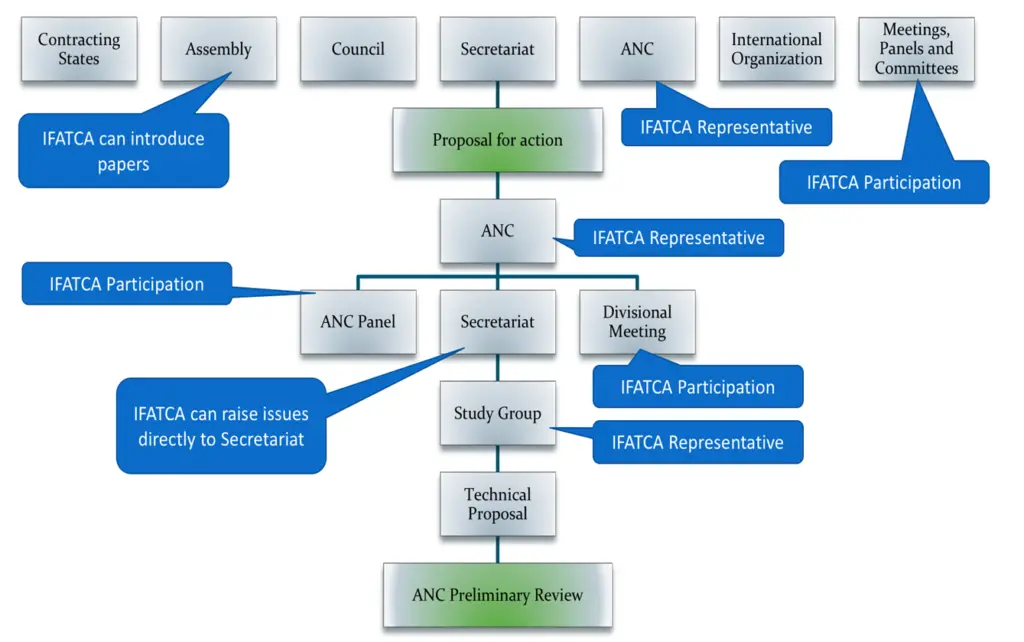
During the Review process...
